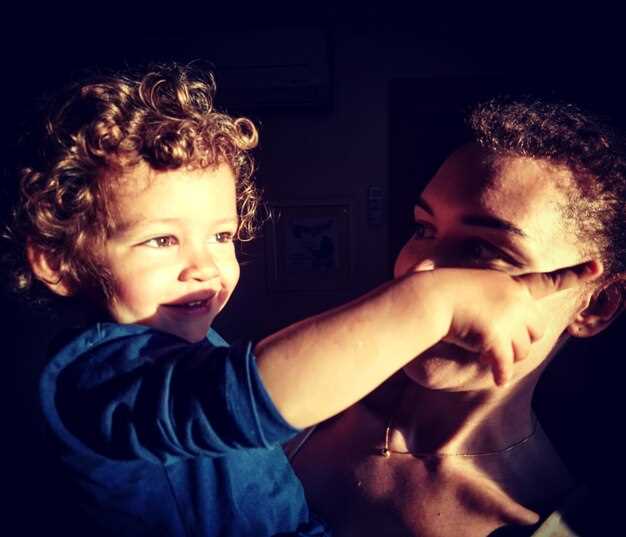Start today: set a 10-minute undistracted check-in. Sit at eye level, ask two open questions and let silence fill the space after each answer; when you stay quiet they finish their thought more often. Keep a timer for two weeks and record whether talks lengthen – most families see clearer reciprocity within 7–21 days.
Use curiosity as a tool: if a child seems reserved, say, “I’m curious about that” rather than lecturing. Encourage them to express a range of feelings by naming what you notice (“You look frustrated”) and modeling vocabulary during reading or play. Small labels plus empathy make it easier for them to understand inner states and for you to picture what they need.
Make routines that lead to predictable connection: a bedtime reading of one short chapter, a two-minute debrief after school, a weekly walk. Consistent efforts beat occasional grand gestures; stick to short practices even on busy days. If you lack time, choose quality over length and prioritize patience – they notice calm presence more than perfection.
Handle conflict with clear, nonjudgmental questions: ask what they meant, what they felt, and what would help next time. When a child said something hurtful, mirror it back neutrally and invite a solution. Track results: note three specific moments each week when the child appeared more valued or willing to talk. That data helps you understand patterns and adjust tactics quickly.
Inconsistent Discipline: Clear steps to stop mixed signals
Set three simple, non-negotiable rules and two predictable consequences, document them on a visible chart, and enforce them every time within 15 minutes of the incident; research and practice show immediate, consistent follow-through increases reliability and reduces escalation.
Agree the rules with all caregivers so theres no mixed messaging: hold a 10‑minute alignment meeting once a week, share the written rules, assign who will lead a consequence if multiple adults are present, and rotate responsibilities so theyre active partners rather than passive observers.
For younger children use time‑outs of roughly one minute per year of age and short loss of a specific privilege for older kids; thats just long enough for de‑escalation but not so long it weakens the learning link. See guidance from the American Academy of Pediatrics: https://www.healthychildren.org/.
Replace vague reprimands with specific coaching: name the unwanted behavior, show the expected alternative, and practice the replacement through a 5‑minute role play. Active practice helps kids learn new skills and gives them a sense of competence and being valued rather than feeling punished.
Prioritize attention and positive interaction: schedule 15 minutes of undivided play or reading together each day; parents reporting more everyday positive attention see fewer repeat incidents. That small, regular investment makes correction moments less frustrating and makes limits feel fair.
Track incidents on a simple log (date, trigger, response, outcome) for four weeks; finding patterns lets you pinpoint triggers, adjust structure, and avoid reactive swings. Data helps you lead changes rather than guessing, and it strengthens consistency across caregivers.
Use a 5:1 ratio of specific praise to correction to strengthen desired behavior; celebrate small wins (they put toys away, they share, they tell the truth) so kids feel encouraged and valued and reliability becomes the norm.
When a lapse happens, repair quickly: apologize if an adult overreacted, explain the correct response, and practice the replacement behavior together; this model teaches human accountability and helps the child learn that rules plus empathy coexist.
If youre curious or frustrated by slow progress, prioritize mental health checks and reading on behavior strategies; sharing progress with a pediatrician or counselor can uncover stressors that weaken discipline efforts and show you how to adjust structure for better outcomes.
How to recognize mixed-discipline patterns in daily routines
Run a seven-day micro-experiment: record every corrective action in a single table with columns: time, context (play/reading/school/meal), who intervened, exact words used, consequence type, immediate response, and follow-up within 30 minutes. Science-backed threshold: mark a pattern “mixed” when identical triggers produce different adult responses in at least 30% of entries; mark “consistent” when the same response appears in ≥70% of entries. This gives a clear baseline instead of vague impressions.
Look for these measurable signals: (1) split rules across caregivers – one lets them continue, another removes privileges the same day; (2) rapid tone swings from neutral to punitive for the same behavior; (3) rules applied for school situations but not at home or during play; (4) language differences – consequence versus conversation. Count occurrences and calculate a consistency ratio: same outcome / total similar incidents. If the ratio falls between 40–69%, treat it as mixed-discipline and address it immediately.
Address insecurity drivers by mapping responsibility: list each routine (morning, homework, bedtime, mealtime, transitions) and assign one primary responder. Use short, scripted if-then phrases parents can stick to – for example, “If you leave toys on stairs, then toys go in bin for the night.” Use calm tone, show them the schedule so they really see what to expect; repetitive, predictable responses are powerful for reducing anxiety and strengthen the caregiver–youngster relationship.
Coordinate with school and external caregivers: share the table and the scripts, note special accommodations, and ask whether school staff observe the same triggers. Also track contexts where reading or play are used as rewards, since inconsistent reward timing creates mixed expectations. Science indicates predictable contingencies improve behavioral regulation faster than ad hoc corrections.
When reviewing data, flag three action items per week: clarify the rule, assign the responder, and rehearse the script aloud with them. Measure progress by watching the consistency ratio climb toward ≥70% and by noting whether the youngster seems less reactive or less likely to test limits. Small, consistent changes strengthen the overall relationship and reduce parental insecurity about discipline decisions.
How to write 3–5 simple, visible household rules
Pick exactly 3–5 rules, phrase each as a short positive command (3–7 words), and limit punctuation to one line per rule – e.g., “Use inside voice”, “Hands to yourself”, “Help tidy toys”.
Print the list twice: one laminated chart at eye level (100–120 cm for preschoolers, 140–150 cm for older kids) and one smaller card on the fridge. Use font size 36–48 px for the poster and 18–24 px for the card so the words remain clear from across a room.
Pair every rule with a simple picture or icon and a matching gesture; a photo of the action helps little learners, and repeated gestures during reminders reduce insecurity about expectations. When a rule is said aloud, point to the picture and use the gesture so youre teaching the cue and the meaning together.
Involve children in wording one rule so theyre invested: let them play with two wording options and pick the clearer one. Prioritize verbs over nouns, avoid vague terms like “respect”, and choose rules that affect daily routines (meals, play, cleanup) so consequences stay relevant and simple.
Decide 1–2 short, related consequences and apply them consistently: immediate correction, a 1-minute-per-year brief pause for reflection, or restoring an item if it was misused. Do not over-react or enforce overly long punishments; stick to the agreed limits so compliance grows instead of resentment.
Model rules yourself and show positive examples: express gratitude when kids follow them, praise specific actions (“You cleaned up the blocks – well done”), and practice the rule during play. Small, regular practice helps finding what works and strengthens predictable routines that lead to calmer life at home.
Review the list weekly for two weeks, tweak wording for clarity if behaviour does not change, and track one metric (number of reminders per day) to measure progress. Sharing responsibility for the chart and celebrating fewer reminders helps curious kids feel capable rather than blamed and makes the system stick.
How to choose consistent, age-appropriate consequences
Use immediate, proportional consequences and enforce them every time: for young kids apply the one-minute-per-year time-out rule; for school-age require 10–30 minutes of restitution or same-day privilege loss; for teens set 24–72 hour privilege suspensions tied to clear restoration steps.
Age-specific table in text form – ages 2–4: 1–4 minute removal of attention or toy; ages 5–7: 10–20 minutes of related cleanup or short tech restriction; ages 8–12: same-day privilege loss plus restitution (30–60 minutes); 13+: loss of driving/device access 24–72 hours coupled with negotiated repair tasks. Prioritize safety over teaching moments and avoid consequences that create a lack of basic needs or humiliation.
Deliver consequences in a calm, gentle tone, show empathy while naming the behavior (“I see you feel angry; hitting hurts”). Encourage children to express how they feel, then state the rule, the consequence, and the restoration step in one short sentence so they clearly learn cause → effect.
Be consistent: follow-through within 60 seconds and stick to the plan at least 9 times out of 10; inconsistency erodes structure and helps misbehavior persist. A steady approach strengthens relationship and helps internalize limits that have life relevance.
Use positive parenting scripts and short, actionable tips: rehearse consequences with role-play, keep a visible one-page chart of rules and consequences, and set predictable routines. Reading short behavioral guides and sharing the plan with co-parents increases alignment. A clear consequence is a rocket–small, predictable, and powerful–for lifelong learning.
How to coordinate responses with partners and other caregivers
Create a one-page protocol that lists three clear responses for common situations (tantrum, refusal, bedtime resistance), name who will lead each response, and rehearse aloud twice weekly so everyone can show the same language and timing.
Use short scripts of 7–12 words that include a positive action and a calm boundary; these scripts should encourage cooperation without being overly permissive. Example: “I see you’re upset; sit with me for two minutes and then choose a book.” Agree that praise focuses on efforts and achievements rather than outcomes so kids feel valued for trying. Consistency across caregivers is a superpower: when they hear the same words and see the same actions, results improve – measure by tracking incident frequency and average calm-down time.
After any upset episode, each caregiver should spend 5 minutes debriefing: say what they observed, what they said, and one tweak for next time. Keep debriefs fact-based to avoid finger-pointing; note any lack of follow-through and assign follow-up tasks. Adopt a curious stance during debriefs: ask two open questions and practice active listening before proposing changes.
| Situation | Agreed response (script) | Lead | Measure / target results |
|---|---|---|---|
| Tantrum in public | “You’re upset; breathe with me for 60 seconds, then we talk.” | Primary caregiver on duty | Reduce public escalations from 4/week to ≤1/week; calm-down time ≤3 min |
| Refusal to follow routine | “Choose one step now, get a small reward after – your effort counts.” | Whomever leads routine | Successful step completion rate ≥80% within 2 weeks; record achievements |
| Bedtime resistance | “Two choices: quiet story or five extra minutes to draw; then lights out.” | Night caregiver | Bedtime start within 15 minutes of target ≥90% nights; fewer repeated protests |
Track these metrics in a shared note and review weekly; celebrate small results and label efforts so kids know they’re valued. If caregivers disagree, pause and test one agreed script for 7 days, then compare objective data. Strong coordination prevents mixed signals that lead to confusion or a lack of trust in the caregiver network and keeps the focus on feelings and the relationship rather than winning an argument.
How to repair trust after a broken promise or uneven punishment
Acknowledge the breach within 24 hours, name what happened, and offer a specific repair action with a deadline (for example: “I missed taking you to the game yesterday; I will be there for Saturday’s practice at 10:00”).
- Immediate steps (first 48 hours)
- Use active listening for 3–5 minutes: sit at their eye level, reflect one feeling and one fact (e.g., “Youre angry that I forgot; I promised to be there”).
- Apologize briefly, state the concrete fix, and set a measurable check: “I’ll call before leaving and I’ll be there; if I can’t make it I’ll tell you 1 hour ahead.”
- Do not justify or deflect; parents who explain motives without repair increase feelings of neglect.
- Short-term repair plan (next 2 weeks)
- Make 5 small, verifiable promises (pick practical items) and keep at least 4 of them. Track them on a simple calendar so kids can see reliability rebuild.
- Schedule two 10-minute sharing sessions per week where they talk and you mirror feelings; aim for active emotional validation rather than solving.
- Introduce one predictable structure: same bedtime routine, chore check, or weekly family meeting to reduce chaos that can weaken trust.
- Correcting uneven punishment
- Address the unfairness aloud: name the action, explain how rules will be applied equally going forward, then solicit their input about what seems fair.
- Replace punitive, unpredictable consequences with short, related restitution tasks (e.g., if screen time removed once but not another time, restore predictable limits and a small restorative task related to the issue).
- Document changes so theres less ambiguity about expectations and enforcement.
- Concrete metrics to rebuild credibility
- Goal: keep 9 of the next 10 small promises and one larger promise within 6 weeks. Mark progress visibly so kids see reliability increasing.
- Hold a weekly tally with them: what was kept, what wasnt, why, and what will change. That steady attention reduces perceptions of neglect.
- Practical touches that matter
- Physical reassurance (brief touches like a hand on a shoulder, a quick hug) after an apology accelerates reconnection; science links safe touch to reduced stress hormones in kids.
- Celebrate small wins: label them (“You noticed I followed through”) and offer a small ritual – a sticker, five-minute choice activity, or a shared snack.
- Language and behavior to avoid
- Avoid vague promises (“I’ll try to be better”) and moralizing lectures; theyre frustrating and hard to measure.
- Do not compare kids or excuse inconsistency as “just this once”; that perception weakens trust more than a single failure.
- Longer-term maintenance
- Every month review whether structure and rules still fit reality; adjust with them so rules feel co‑created, not imposed.
- Prioritize predictable routines for chores and rewards; consistency reduces administrative friction and the temptation to unevenly punish.
- Quick tips
- When a promise will be broken, give advance notice plus a replacement plan.
- Turn apologies into action: replace “I’m sorry” with “I will X by Y.”
- Use objective markers (calendar, timers, short written pacts) so reliability is visible.
Finding the balance between attention and structure repairs trust faster than explanations alone; whether the issue started from a single missed promise or patterns of uneven discipline, steady, measurable follow-through really restores confidence in parents and helps kids feel safe in their world.


 7 Ways to Build a Strong Emotional Bond With Your Child">
7 Ways to Build a Strong Emotional Bond With Your Child">



 Review – Falling Out of Love with Ideology in Election Season">
Review – Falling Out of Love with Ideology in Election Season">
 SomaliNet Forums – Somali Community Discussions & Support">
SomaliNet Forums – Somali Community Discussions & Support">
 15 Common Relationship Problems – Causes & Solutions">
15 Common Relationship Problems – Causes & Solutions">
 Worst Things to Do on a First Date — According to Millennials">
Worst Things to Do on a First Date — According to Millennials">
 7 Proven Ways to Build Trust in a Relationship — Expert Tips">
7 Proven Ways to Build Trust in a Relationship — Expert Tips">
 The Need for Deeper Conversations – Why Meaningful Dialogue Matters">
The Need for Deeper Conversations – Why Meaningful Dialogue Matters">
 10 Signs Your Husband Doesn’t Love You Anymore – A Family Law Perspective">
10 Signs Your Husband Doesn’t Love You Anymore – A Family Law Perspective">
 Turning Red Flags into Green Flags – How to Rebuild Trust in Relationships">
Turning Red Flags into Green Flags – How to Rebuild Trust in Relationships">
 The Only Type of Woman a Man Will Never Leave — 7 Traits">
The Only Type of Woman a Man Will Never Leave — 7 Traits">
 Betrayal of Trust – How to Recognize, Heal & Rebuild">
Betrayal of Trust – How to Recognize, Heal & Rebuild">